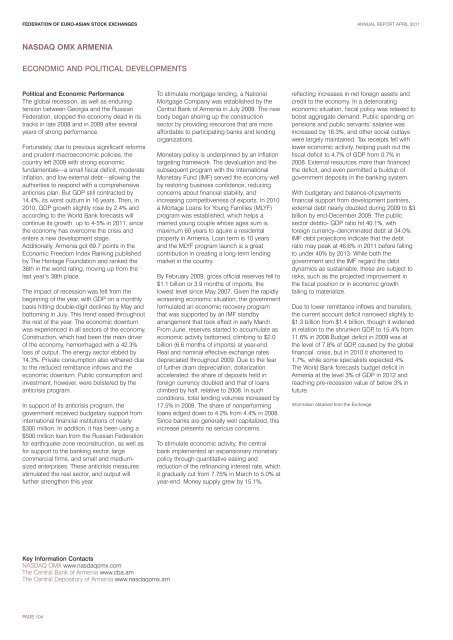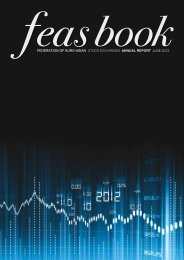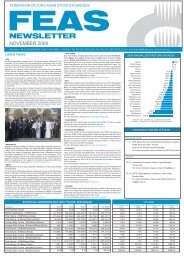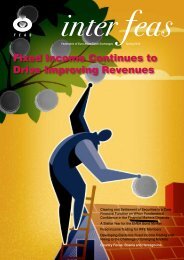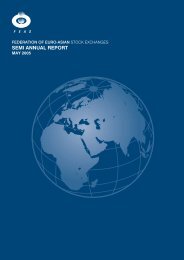Download - FEAS
Download - FEAS
Download - FEAS
You also want an ePaper? Increase the reach of your titles
YUMPU automatically turns print PDFs into web optimized ePapers that Google loves.
FEDERATION OF EURO-ASIAN STOCK EXCHANGES ANNUAL REPORT APRIL 2011<br />
NASDAQ OMX ARMENIA<br />
ECONOMIC AND POLITICAL DEVELOPMENTS<br />
Political and Economic Performance<br />
The global recession, as well as enduring<br />
tension between Georgia and the Russian<br />
Federation, stopped the economy dead in its<br />
tracks in late 2008 and in 2009 after several<br />
years of strong performance.<br />
Fortunately, due to previous significant reforms<br />
and prudent macroeconomic policies, the<br />
country left 2009 with strong economic<br />
fundamentals—a small fiscal deficit, moderate<br />
inflation, and low external debt—allowing the<br />
authorities to respond with a comprehensive<br />
anticrisis plan. But GDP still contracted by<br />
14.4%, its worst outturn in 16 years. Then, in<br />
2010, GDP growth slightly rose by 2.4% and<br />
according to the World Bank forecasts will<br />
continue its growth up to 4-5% in 2011, since<br />
the economy has overcome the crisis and<br />
enters a new development stage.<br />
Additionally, Armenia got 69.7 points in the<br />
Economic Freedom Index Ranking published<br />
by The Heritage Foundation and ranked the<br />
36th in the world rating, moving up from the<br />
last year’s 38th place.<br />
The impact of recession was felt from the<br />
beginning of the year, with GDP on a monthly<br />
basis hitting double-digit declines by May and<br />
bottoming in July. This trend eased throughout<br />
the rest of the year. The economic downturn<br />
was experienced in all sectors of the economy.<br />
Construction, which had been the main driver<br />
of the economy, hemorrhaged with a 42.3%<br />
loss of output. The energy sector ebbed by<br />
14.3%. Private consumption also withered due<br />
to the reduced remittance inflows and the<br />
economic downturn. Public consumption and<br />
investment, however, were bolstered by the<br />
anticrisis program.<br />
In support of its anticrisis program, the<br />
government received budgetary support from<br />
international financial institutions of nearly<br />
$300 million. In addition, it has been using a<br />
$500 million loan from the Russian Federation<br />
for earthquake zone reconstruction, as well as<br />
for support to the banking sector, large<br />
commercial firms, and small and mediumsized<br />
enterprises. These anticrisis measures<br />
stimulated the real sector, and output will<br />
further strengthen this year.<br />
To stimulate mortgage lending, a National<br />
Mortgage Company was established by the<br />
Central Bank of Armenia in July 2009. The new<br />
body began shoring up the construction<br />
sector by providing resources that are more<br />
affordable to participating banks and lending<br />
organizations.<br />
Monetary policy is underpinned by an inflation<br />
targeting framework. The devaluation and the<br />
subsequent program with the International<br />
Monetary Fund (IMF) served the economy well<br />
by restoring business confidence, reducing<br />
concerns about financial stability, and<br />
increasing competitiveness of exports. In 2010<br />
a Mortage Loans for Young Families (MLYF)<br />
program was established, which helps a<br />
married young couple whose ages sum is<br />
maximum 60 years to aquire a residental<br />
property in Armenia. Loan term is 10 years<br />
and the MLYF program launch is a great<br />
contribution in creating a long-term lending<br />
market in the country.<br />
By February 2009, gross official reserves fell to<br />
$1.1 billion or 3.9 months of imports, the<br />
lowest level since May 2007. Given the rapidly<br />
worsening economic situation, the government<br />
formulated an economic recovery program<br />
that was supported by an IMF standby<br />
arrangement that took effect in early March.<br />
From June, reserves started to accumulate as<br />
economic activity bottomed, climbing to $2.0<br />
billion (6.6 months of imports) at year-end.<br />
Real and nominal effective exchange rates<br />
depreciated throughout 2009. Due to the fear<br />
of further dram depreciation, dollarization<br />
accelerated: the share of deposits held in<br />
foreign currency doubled and that of loans<br />
climbed by half, relative to 2008. In such<br />
conditions, total lending volumes increased by<br />
17.5% in 2009. The share of nonperforming<br />
loans edged down to 4.2% from 4.4% in 2008.<br />
Since banks are generally well capitalized, this<br />
increase presents no serious concerns.<br />
To stimulate economic activity, the central<br />
bank implemented an expansionary monetary<br />
policy through quantitative easing and<br />
reduction of the refinancing interest rate, which<br />
it gradually cut from 7.75% in March to 5.0% at<br />
year-end. Money supply grew by 15.1%,<br />
reflecting increases in net foreign assets and<br />
credit to the economy. In a deteriorating<br />
economic situation, fiscal policy was relaxed to<br />
boost aggregate demand. Public spending on<br />
pensions and public servants’ salaries was<br />
increased by 16.3%, and other social outlays<br />
were largely maintained. Tax receipts fell with<br />
lower economic activity, helping push out the<br />
fiscal deficit to 4.7% of GDP from 0.7% in<br />
2008. External resources more than financed<br />
the deficit, and even permitted a buildup of<br />
government deposits in the banking system.<br />
With budgetary and balance-of-payments<br />
financial support from development partners,<br />
external debt nearly doubled during 2009 to $3<br />
billion by end-December 2009. The public<br />
sector debtto- GDP ratio hit 40.1%, with<br />
foreign currency–denominated debt at 34.0%.<br />
IMF debt projections indicate that the debt<br />
ratio may peak at 46.6% in 2011 before falling<br />
to under 40% by 2013. While both the<br />
government and the IMF regard the debt<br />
dynamics as sustainable, these are subject to<br />
risks, such as the projected improvement in<br />
the fiscal position or in economic growth<br />
failing to materialize.<br />
Due to lower remittance inflows and transfers,<br />
the current account deficit narrowed slightly to<br />
$1.3 billion from $1.4 billion, though it widened<br />
in relation to the shrunken GDP, to 15.4% from<br />
11.6% in 2008.Budget deficit in 2009 was at<br />
the level of 7.8% of GDP, caused by the global<br />
financial crisis, but in 2010 it shortened to<br />
1.7%, while some specialists expected 4%.<br />
The World Bank forecasts budget deficit in<br />
Armenia at the level 3% of GDP in 2012 and<br />
reaching pre-recession value of below 3% in<br />
future.<br />
Information obtained from the Exchange.<br />
Key Information Contacts<br />
NASDAQ OMX www.nasdaqomx.com<br />
The Central Bank of Armenia www.cba.am<br />
The Central Depository of Armenia www.nasdaqomx.am<br />
PAGE 104


